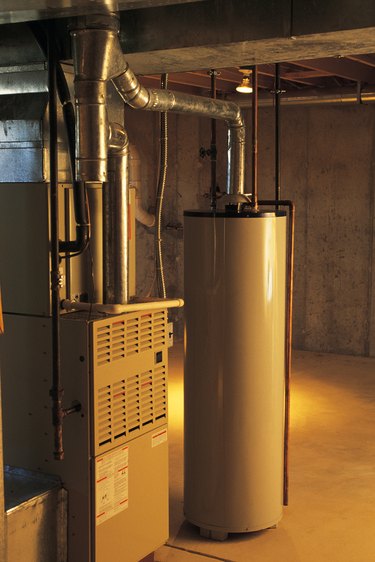
A furnace that's old is a furnace that's inefficient. If your furnace is 15 to 20 years old, your heating bills may be far more than they need to be. New modulating furnaces and two-stage furnaces are highly efficient and will reduce your gas and electricity consumption and costs. When it's time to finally replace your furnace, make smart buying decisions by knowing how modulating and two-stage furnaces work to select a furnace that makes your home more comfortable, energy-efficient and less costly to heat.
Modulating
Video of the Day
Modulating furnaces -- also called multi-stage furnaces -- are the most efficient furnaces on the market. They typically have an Annual Fuel Utilization Efficiency (AFUE) rating of 94 percent or more, according to the U.S. Department Of Energy. Modulating furnaces selectively and efficiently fluctuate in the amount of operating capacity they utilize. For example, a furnace may start using 40 percent of its capacity and then ramp up to either 65 or 100 percent of the furnace's overall heating capacity during operation.
Video of the Day
Two-Stage
A two-stage furnace -- also called a variable-speed furnace -- is one type of modulating furnace. For example, a two-stage furnace may start in stage one and only use 40 percent of its capacity to achieve the desired indoor temperature on the thermostat. Then, if the thermostat detects that more capacity is needed, it will ramp up to its second stage and use 100 percent of its heating capacity to maintain the desired temperature.
Similarities
Unlike single-stage furnaces, modulating and two-stage furnaces have variable-speed motors. A single-stage furnace is either on or off; however, the motor for a modulating or two-stage furnace remains on continually at variable motor speeds. As a result, you don't notice radical indoor temperature fluctuations with modulating and two-stage furnaces. They use the same principles for efficient selection of variable motor speeds, operating at 40, 65 or 100 percent of capacity to deliver cool air through the duct work and vents in the summer when combined as a component of your home's central air conditioning system.
Differences
A modulating furnace is the category term used to describe other-than single stage furnaces while the term two-stage furnace indicates that the furnace has two motor speeds. Essentially, a two-stage furnace is a member of the modulating furnace "family." Additional types of modulating furnaces include condensing furnaces and high-efficiency models. Modulating condensing furnaces have AFUE ratings as high as 98 for gas-fueled models and close to 100 percent for electric units. Two-stage furnace AFUE ratings typically top out at 97 percent, which is still quite high compared to other types of furnaces. For example, a 20-year-old, single-stage furnace might have an AFUE rating of 70 percent or less. This means 30 percent of the energy paid for is wasted and unused for heating or cooling. However, if that furnace were replaced with a modulating or two-stage furnace with a 97 percent efficiency rating, only 3 percent or less would be wasted.